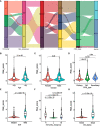Immune Gene Signatures and Immunotypes in Immune Microenvironment Are Associated With Glioma Prognose
- PMID: 35493457
- PMCID: PMC9046586
- DOI: 10.3389/fimmu.2022.823910
Immune Gene Signatures and Immunotypes in Immune Microenvironment Are Associated With Glioma Prognose
Abstract
Glioma is the most common primary malignant brain tumor in adults with very poor prognosis. The limited new therapeutic strategies for glioma patients can be partially attributed to the complex tumor microenvironment. However, knowledge about the glioma immune microenvironment and the associated regulatory mechanisms is still lacking. In this study, we found that, different immune subtypes have a significant impact on patient survival. Glioma patients with a high immune response subtype had a shorter survival compared with patients with a low immune response subtype. Moreover, the number of B cell, T cell, NK cell, and in particular, the macrophage in the immune microenvironment of patients with a high immune response subtype were significantly enhanced. In addition, 132 genes were found to be related to glioma immunity. The functional analysis and verification of seven core genes showed that their expression levels were significantly correlated with the prognosis of glioma patients, and the results were consistent at tissue levels. These findings indicated that the glioma immune microenvironment was significantly correlated with the prognosis of glioma patients and multiple genes were involved in regulating the progression of glioma. The identified genes could be used to stratify glioma patients based on immune subgroup analysis, which may guide their clinical treatment regimen.
Keywords: glioma; immune microenvironment; immunotherapy; immunotype; macrophages.
Copyright © 2022 Wang, Cao, Zhai, Deng, Chao, Hu, Mou, Guo, Zhao, Li, Jiao, Xue, Han, Zhang and Wang.
Conflict of interest statement
The authors declare that the research was conducted in the absence of any commercial or financial relationships that could be construed as a potential conflict of interest.
Figures









Similar articles
-
Investigation of Genetic Determinants of Glioma Immune Phenotype by Integrative Immunogenomic Scale Analysis.Front Immunol. 2021 Jun 16;12:557994. doi: 10.3389/fimmu.2021.557994. eCollection 2021. Front Immunol. 2021. PMID: 34220791 Free PMC article.
-
Prognostic Gene Expression Signature in Patients With Distinct Glioma Grades.Front Immunol. 2021 Sep 1;12:685213. doi: 10.3389/fimmu.2021.685213. eCollection 2021. Front Immunol. 2021. PMID: 34539626 Free PMC article.
-
Comprehensive analysis of TAMs marker genes in glioma for predicting prognosis and immunotherapy response.Mol Immunol. 2022 Apr;144:78-95. doi: 10.1016/j.molimm.2022.02.012. Epub 2022 Feb 21. Mol Immunol. 2022. PMID: 35203024
-
Insights of immune cell heterogeneity, tumor-initiated subtype transformation, drug resistance, treatment and detecting technologies in glioma microenvironment.J Adv Res. 2025 Jun;72:527-554. doi: 10.1016/j.jare.2024.07.033. Epub 2024 Aug 5. J Adv Res. 2025. PMID: 39097088 Free PMC article. Review.
-
Pivotal Role of STAT3 in Shaping Glioblastoma Immune Microenvironment.Cells. 2019 Nov 6;8(11):1398. doi: 10.3390/cells8111398. Cells. 2019. PMID: 31698775 Free PMC article. Review.
Cited by
-
The Immunomodulatory Effects of Fluorescein-Mediated Sonodynamic Treatment Lead to Systemic and Intratumoral Depletion of Myeloid-Derived Suppressor Cells in a Preclinical Malignant Glioma Model.Cancers (Basel). 2024 Feb 15;16(4):792. doi: 10.3390/cancers16040792. Cancers (Basel). 2024. PMID: 38398183 Free PMC article.
-
Identification of prognostic risk score of disulfidptosis-related genes and molecular subtypes in glioma.Biochem Biophys Rep. 2023 Dec 17;37:101605. doi: 10.1016/j.bbrep.2023.101605. eCollection 2024 Mar. Biochem Biophys Rep. 2023. PMID: 38188362 Free PMC article.
-
Integrated MRI radiomics, tumor microenvironment, and clinical risk factors for improving survival prediction in patients with glioblastomas.Strahlenther Onkol. 2025 Apr;201(4):398-410. doi: 10.1007/s00066-024-02283-x. Epub 2024 Sep 9. Strahlenther Onkol. 2025. PMID: 39249499
-
Glioma immune microenvironment composition calculator (GIMiCC): a method of estimating the proportions of eighteen cell types from DNA methylation microarray data.Acta Neuropathol Commun. 2024 Oct 28;12(1):170. doi: 10.1186/s40478-024-01874-0. Acta Neuropathol Commun. 2024. PMID: 39468647 Free PMC article.
-
Elevated Antigen-Presenting-Cell Signature Genes Predict Stemness and Metabolic Reprogramming States in Glioblastoma.Int J Mol Sci. 2025 Aug 1;26(15):7411. doi: 10.3390/ijms26157411. Int J Mol Sci. 2025. PMID: 40806540 Free PMC article.
References
MeSH terms
LinkOut - more resources
Full Text Sources
Medical

